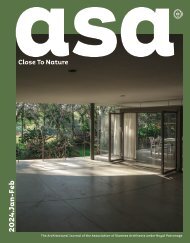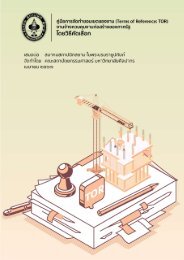ASA JOURNAL 11/2023
Create successful ePaper yourself
Turn your PDF publications into a flip-book with our unique Google optimized e-Paper software.
56<br />
theme<br />
CONCRETE CONSTRUCT CONCEPTION<br />
57<br />
09<br />
Photo courtesy of Medios Audiovisuales FADU – UdelaR © Silvia Montero 2006<br />
Concrete is a material that can perform without being a<br />
protagonist. It is a relationship builder, encouraging sharing<br />
rather than monopoly and openness rather than seclusion.<br />
สำาหรับ Otto สมมติฐานของโครงสร้างคอนกรีตใน Ökohaus<br />
อาจทำางานในทิศทางเดียวกับวิธีคิด Membrane Structure<br />
ที่ผ่านมาของเขา มันคือการให้อิสระกับผู้คน โดยการยอมรับ<br />
ข้อเรียกร้องต่างๆ ผ่านเอกลักษณ์ของโครงสร้างบางอย่าง<br />
เป็นความพยายามที่จะก้าวข้ามระบบที่สร้างบนกฏเดี่ยวของ<br />
คนๆ เดียว ความดีงามของโครงการนี้ อาจจะอยู่ตรงที่ ระหว่าง<br />
ที่ Otto เปิดพื้นที่และกระบวนการ ให้ผู้อื่นเข้ามามีส่วนร่วม<br />
เขาก็ไม่ละทิ้งการออกแบบ อย่างที่ Otto กล่าวว่า “มันคือ<br />
การทดลอง ว่า เราสามารถให้อิสระกับผู้คนได้แค่ไหน” 9<br />
แผ่นพื้นคอนกรีต ในโครงการ Ökohaus ไม่ได้เป็นแค่โครง-<br />
สร้างพื้นฐานทางกายภาพ แต่เป็นโครงสร้างและสัญลักษณ์<br />
ที่เข้มแข็งของกระบวนการมีส่วนร่วม ระหว่างการออกแบบ<br />
และก่อสร้าง เมื่อการก่อสร้างคืบหน้า ขอบแผ่นพื้นถูกหุ้ม<br />
ด้วยไม้ และประกบด้วยราวจับ พื้นคอนกรีตกลายสภาพ<br />
เป็นระเบียงจำานวนมาก ภายใต้ต้นไม้ที่เขียวชอุ่ม สัญลักษณ์<br />
ที่ประกาศตัวตน ค่อยๆ หายกลืนไปกับโครงการ จนแทบไม่<br />
สามารถมองเห็นได้ กลายเป็น “infra” structure อย่างแท้จริง<br />
Perhaps for Otto, the pioneer in Membrane<br />
Structure, his hypothesis on concrete in Ökohaus<br />
operates without any conflict against the concept<br />
in his membrane architecture. It is about ensuring<br />
each participant's freedom by embracing the different<br />
requirements into an entity, an attempt to<br />
overcome the system based on the single principle<br />
of a single planner. The virtue of the project is that<br />
while the architect releases his domain to others<br />
exceptionally, he still never gives up on planning.<br />
"It is just an experiment. I wanted to know how<br />
much freedom you can give to people." 9<br />
The concrete slab in Ökohaus is more than physical<br />
infrastructure – it is a structure and symbol during<br />
participation in the design and the construction<br />
process. As construction progresses, the edge is<br />
covered with wood and anchored with railings,<br />
transforming it into balconies behind lush greenery.<br />
Over time, this once-potent symbol becomes less<br />
and less visible until it virtually disappears, literally<br />
becoming an "infra" structure.<br />
09-10<br />
Citrícola Salteña S.A.<br />
โดย Eladio Dieste เมื่อ<br />
ปี 2006 เป็น Double<br />
Curvature Vaults span<br />
กว้าง 34m ครอบคลุม<br />
พื้นที่ 2,200 ตารางเมตร<br />
สร้างเสร็จเมื่อปี 1976<br />
SYSTEM<br />
คอนกรีตเป็นวัสดุที่สามารถแสดงความสามารถได้ โดยไม่<br />
ต้องเป็นพระเอก คอนกรีต วางตัวเองในฐานะผู้เชื่อมความ<br />
สัมพันธ์ สนับสนุนความสัมพันธ์แบบเปิด ไม่ใช่ปิด สนับสนุน<br />
ความสัมพันธ์แบบเผื่อแผ่ ไม่ใช่ผูกขาด<br />
ความพยายามที่จะสร้างสถาปัตยกรรมคลุม พื้นที่ขนาดใหญ่<br />
ถูกทดลองผ่านโครงสร้างคอนกรีตเสริมเหล็กมายาวนาน<br />
ตั้งแต่ Eduardo Torraja ผู้ก่อตั้ง IASS, Pier Luigi Nervi หรือ<br />
Felix Candela รวมถึง Eladio Dieste<br />
ในยุค 50s ประเทศอุรุกวัยเข้าสู่วิกฤตทางเศรษฐกิจที่ลากยาว<br />
ต่อจากนั้นไปกว่ายี่สิบปี ในระหว่างสถานการณ์ขาดแคลน<br />
ทรัพยากรนี้เอง ที่ Eladio Dieste ค่อยๆสร้างและพัฒนางาน<br />
ของเขา ผ่านโครงสร้างอิฐ (ผสมคอนกรีต) เสริมเหล็ก ที่<br />
เรียกว่า Cerámica Armada<br />
ต่างจากคอนกรีต ที่มีส่วนผสมของซีเมนต์ อิฐมีรูเป็นวัสดุ<br />
ที่สามารถผลิตได้ด้วยวัสดุและแรงงานท้องถิ่นล้วนๆ สำาหรับ<br />
Dieste อิฐเบากว่า และแห้งกว่า การใช้อิฐมีรูสามารถช่วยลด<br />
ระยะเวลารอให้แห้ง และปริมาณไม้แบบระหว่างการก่อสร้าง<br />
ได้ นอกจากนั้นยังช่วยสร้างผลผลิตให้กับชุมชน<br />
Dieste ใช้ช่องว่างในความแข็งแรงที่มากเกินไปของคอนกรีต<br />
โดยแบ่งหน้าตัดของหลังคาโครงสร้างเปลือกบาง กว่าครึ่งให้<br />
กับอิฐมีรูที่ทนแรงอัดได้น้อยกว่าคอนกรีตมาก แต่ก็เพียงพอ<br />
สำาหรับโครงสร้างเปลือกบาง คอนกรีตมวลเบาถูกเทไปใน<br />
ช่องว่างระหว่างอิฐ ที่มีเหล็กเส้นวางไว้ก่อนแล้ว เพื่อให้เหล็ก<br />
เส้นเหล่านั้น สามารถถ่ายทอดแรงได้อย่างเต็มที่ พื้นผิวใหม่<br />
ที่เชื่อมต่ออิฐให้เป็นผืนเดียวกันนี้ ดูเผินๆ เหมือนเป็นเพียง<br />
วัสดุยาแนวของอิฐ หรือพื้นผิวกันน้ำ าให้กับตัวโครงสร้าง<br />
คอนกรีตเป็นวัสดุที่สำาคัญ ที่ส่งผลกระทบโดยตรงต่อ<br />
ทรัพยากร แรงงาน โครงสร้างและกระบวนการก่อสร้างความ<br />
เกี่ยวพัน และความสัมพันธ์ของสิ่งเหล่านี้ คือตัวกำ าหนดรูปร่าง<br />
ของระบบการผลิตสถาปัตยกรรม ความพิเศษของ Dieste<br />
คือความใส่ใจในการสร้างดุลยภาพของระบบ ที่ให้ความ<br />
สำาคัญกับทุกๆ องค์ประกอบ โดยไม่ได้หมายถึงแค่โครงสร้าง<br />
ทางกายภาพ หรือความคุ้มทุนทางเศรษฐกิจ แต่หมายรวมถึง<br />
สังคม และบริบท ที่ถูกสร้างไปพร้อมกัน ณ เวลานั้น Dieste<br />
มองคอนกรีตในฐานะส่วนหนึ่งของภาพกว้าง เป็นองค์ประกอบ<br />
ที่ร่วมสร้างสถานะสมดุลของระบบ ที่เขาเรียกมันว่า Cosmic<br />
Economy เป็นการนำาเสนอระบบโครงสร้างที่ตั้งคำาถามกับ<br />
ความศรัทธาต่อคอนกรีตของสถาปัตยกรรมสมัยใหม่ เป็น<br />
การท้าทาย ความหลงไหลที่ยึดติดต่อความบริสุทธิ์ของคอน-<br />
กรีต ด้วยปฏิบัติการแทนที่ในระดับส่วนประกอบและรูปตัด<br />
ทางโครงสร้าง<br />
SYSTEM<br />
Concrete is a material that can perform without<br />
being a protagonist. It is a relationship builder,<br />
encouraging sharing rather than monopoly and<br />
openness rather than seclusion.<br />
Countless attempts to create a vast roof span<br />
have been long tested through reinforced concrete<br />
structures, from Eduardo Torraja to Pier Luigi Nervi,<br />
Felix Candela to Eladio Dieste.<br />
In the 1950s, Uruguay entered an economic crisis<br />
for over twenty years. During this scarcity of<br />
resources, Eladio Dieste gradually built and developed<br />
his work through a steel-reinforced brick<br />
(+concrete) structure known as Cerámica Armada.<br />
A structural method that relativized the absolute<br />
faith in modern concrete on a technical level.<br />
Differing from concrete, which consists of cement,<br />
brick can be produced entirely by local materials<br />
and labor. For Dieste, brick is lighter and drier,<br />
which help reduces the timber required for support<br />
and formwork during construction. Most of all, it<br />
helps contribute to the community's local production<br />
activities.<br />
The compressive stress strength required for the<br />
shell is lower than that of concrete. In other words,<br />
concrete is too strong, depending on its form. Dieste<br />
takes this excessive strength of concrete and<br />
replaces more than half of the section with hollow<br />
bricks, which can bear much less compression.<br />
Lightweight concrete is poured to fill the gaps between<br />
bricks with rebar for bending reinforcement.<br />
This newly formed surface may seem to be just the<br />
sealant of the bricks or a waterproof cover for the<br />
structure.<br />
Concrete is a material that directly impacts the<br />
structure, resource, labor, and construction process.<br />
The involvement of these issues and their<br />
interrelationships shape a system of architecture.<br />
By giving equal importance to concrete and other<br />
components rather than solely focusing on concrete,<br />
Dieste sought to create a state of equilibrium in<br />
the system, which depended not just on economic<br />
viability but also on society and the context<br />
created concurrently. Here, concrete is viewed as<br />
part of a larger picture, part of a state which he<br />
called "cosmic economy." A rigid adherence to<br />
'concrete's unity and purity in structural composition<br />
was challenged and replaced by a radical<br />
relativization of concrete.


















